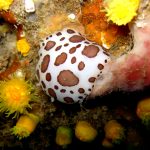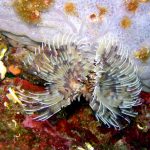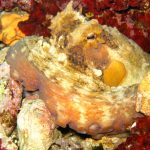Our diving spots
Wrecks and caves. Rocky peaks and Posidonia meadows. Vertical walls and coralligenous fractions.
A unique morphological and biological variety to be discovered!
Secca del Papa 1
The most famous dive in this area, and rightly considered to be among the most beautiful in the Mediterranean, as much for its morphology as for its marine life. It is possible to see the majority of the bentonic and nectonic species to be found in the Mediterranean. It is a challenging dive due to the depth and frequent currents, with a series of limestone pinnacles, aligned from north-east to south-west, rising from a depth of 40-42 metres. The highest pinnacle reaches around 15 metres; others vary between 24 and 32. The northwest side of these pinnacles is composed of a vertical wall, completely covered with a dense field of large red sea fans (Paramuricea clavata). The rare and beautiful yellow or red and yellow variety of sea fans may also be found. The southern side, on the other hand, descends gradually with numerous cracks and gorges that shelter moray eels, often in pairs, as well as greater forkbeards and crustaceans such as squill, spider crab and Spiny Squat Lobster. Continuing towards the deeper gorges, we meet countless groupers, some of remarkable dimensions, and if we are lucky, we can admire great majestic examples of dentex, shyly maintaining a certain distance. A pair of golden groupers, who seem to have taken up residence in these shallows are just as shy. In September and October it is not rare to meet tuna, greater amberjacks and Atlantic bonitos. Over the last few years, a considerable shoal of barracuda has become a permanent feature. Resurfacing is usually performed in a spiral around the highest pinnacle, exploring every crack in the rock, glancing now and then into the view below, teaming with life. Sargassum grow at the tip of the pinacle, enveloped in a cloud of damselfish and anthias, and it is often possible to see sea urchins (Centrostephanus longispinus), ready to point their long spines towards any possible aggressor. Numerous shoals graze on the hydrozoa. And finally, while waiting to ascend safely, as you gaze into the blue, you may happen to see some large pelagic or ocean sunfish, or perhaps even a blue shark!
Secca del Papa 2
At about a hundred metres north east of “ PAPA 1” there is a granite elevation rising from a seabed of 40-42 metres depth, housing marine life quite similar to that found around the principle PAPA 1 pinnacle. The main difference is that the shallows lie at a greater depth, here of around 24 metres. We can see a bit of everything here too: from great red sea fans, to their red and yellow variety, or small shoals of sea slugs (Flabellina affinis and cratena peregnina), numerous silver barracuda and large dentex that parade quickly along the edges of the shallows. Many groupers may also be seen, some of considerable dimensions, curious and shy at the same time they seem to play hide and seek with the divers. The show offered by the elegant movements of a shoal of large black-umber is not to be missed. A brief dive, given the depth, but full of intense emotions that will be remembered at length.
Grottone
Another naturalistically rich dive is offered by this large cavity, it opens up from under the regal limestone cliff of the Tavolara, at a depth of 12-14 metres. From the buoy it is necessary to continue for 20-40 metres with the wall on the left to reach the cave. The outside of the cave is covered with a mantle of green algae, sciafile and red algae, while inside, where the light rarely penetrates, bryozoa and coelenterates fight for every centimetre of available surface, creating an incredible variety of colours that only the light of a torch may discover. It is easy to see dotted sea slugs grazing on sponges and hydrozoa, or ceriantus scattered here and there along the sandy, sediment bottom of the cave. For those who love greater depths and larger fish, going down to 30metres to look for “Nerone”, a large example of brown grouper is “a must”.
Tedja Liscia
This is the most classic of the Tavolara wall dives. It is possible to follow several different routes, all equally interesting given the richness of life, therefore the dive is suitable for all levels of diving experience. Here the limestone cliff falls vertically from the surface down to 8-10 metres depth, where we find a softly descending table, scattered with limestone masses giving shelter to magnoses, that gather numerously during the spring in the deeper depths to mate. Here and there anemone stand out, with their tiny camouflaged inhabitants: spider crabs and transparent shrimp. Already within the first 10 metres, we will be surrounded by an environment teaming with life, damselfish, saddled seabream, shoals of common two-banded seabream as well as numerous large white seabream, one of which seems to have befriended divers, to the point of following them for most of their dive, generously posing for close ups. Leaving the wall of the Tavolara, large rocks alternate with landslides full of gorges, tunnels and passageways. Grazing on a thin layer of algae in the illuminated areas, it is possible to see numerous astree (Astraea rugosa) as well as ever present Salemas, and large red starfish( Ophidiaster ophidianus),while the shady areas are covered with Leptosammia provato, sea daisies (Parazoanthus axinellae) and coloured sponges. Going east you encounter a beautiful precoralligenous environment that shelters black-umber and a couple of large groupers, who happily allow you to come close, demonstrating the optimum results achieved by marine conservation.
Occhio di Dio
There is a long fracture along one side of the Tavolara, a few metrres under the surface, which forms a triangular cave with a rock right in its centre: resembeling the classic figure of the eye of god. The fracture continues up to 15 metres depth under water, terminating in a long stretch of fine white sand. The walls of the fracture are covered with red alghe, bryozoa sponges and spirografi. We find ourselves in a tipical coralline environment, such as is usually found in deeper water. At the beginning of the summer large squill take up residence for mating before returning to the greater depths. To the east and west of the fracture, a landslide of rocks shelters large groupers, moray eels and a mutitude of yellow sea fans. At the foot of the landslide, around 25-27 metres depth, there are a couple of large limestone blocks in the shape of a mushroom, their shaded walls covered with colours like a painter’s palate.
Cala cicale
Another great dive of the Tavolara, offering a unique show: in a sunken cavity in the wall it is possible to count 10-11 examples of magnoses, some of considrable dimensions, that find the ideal place for reproduction. From which the name of the location. The limestone cliff in this part of the island descends vertically to a rocky plateau, covered here and there with posidonia, at an average depth of 12-14 metres. Visibility is usually very good , and the current, if present is weak, consequently the dive is suitable for everyone. From the mooring buoy it is necessary to continue for 20-40 metres* with the wall on the right to reach the “grottino delle cicale” swimming among damselfish, Saddled seabream and Common two-banded seabream. It is easy to see the slim silvery profiles of baracuda or some young groupers looking curiously out from befind a rock.
Archetto
An interesting dive because it winds through sediments of detritus, piles of stones, passages under the immense boulders that collapsed from the overlying cliff. A dense prairie of Posidonia covers the whole slope, here can be observed numbers of fish that hide in these ravines. Although the maximum depth that is reached does not exceed -20 meters, and that the average altitude of navigation is between the -8 meters and -14 meters, there are many points of interest and the forms of animal and plant life that can be encountered in this dive.
Beach rock di Spalmatore
To the north of the strip of land of Spalmatore, at a depth varying between 3 and 14 metres, great slabs of granite indicate the ancient fosilised coast line. At one time mistaken for a submersed roman road, the wide flat granite slabs lie on a sea bed at times rocky, at times of ample stretches of white sand, offering shelter to seabream and black umber. Half way down it is possible to see black seabream and saddled seabream, and above all in the springtime you may see dentex or greater amberjack. Visibility and light are usually exceptional, making the location a great place also for snorkelling.
I. Reulino
The mmoring buoy is to the south of the island, sheltered from maestral winds. It is a simple dive because it is between 5 and 15 metres depth, but none less interesting than the others because of this. On the contrary, the limited depth and the variety of habitats found close together (rock, sand and meadows of posidonia) make this location particualrly rich in a variety of species. We will be able to see numerous miniscule shoals grazing on Hydrozoa or sponges, hermit crabs moving from one ravine to another, protected by the darkness, curious groupers poping out of their lairs, hunting detex and above all a shoal of baracuda, a resident feature which is more numerous every year, swimming circles in the water, allowing the divers to come close, undisturbed in any why by their air bubbles.
Secca dell'elefante
In the continuation of the ridge that starts from the rock of the fig tree, there is an amazing rock formation that represents an enormous elephant head, complete with an ear and a trunk resting on the stone. The immersion is a swim, between – 14 and -35 meters, between large granite boulders resting on the sand and surrounded by a beautiful grassland of Posidonia; in the numerous fissures dromie and galatee, two types of crab can be observed, the mechanical prawns, the musdee, moray eels and conger eels, scarves and castagnole that frame the bream, the glances and the brown groupers that swim mid-water.
Secca del Fico
Situated between Tavolara and Molara, to the north-west of the same island, and constituted by a series of granite emergenze, very simmilar to those found out of the water. You descend on a large cake shaped rock, with a “roof” of 11 metres, surrounded by heaps of rocks that shelter black umber, groupers, scorpion fish and white seabream. Large shoals of salemas graze here and there on the layer of alghe that covers the rocks, and sometimes it is possible to see pelagic such as dentex or greater amberjacks, carrying out quick raids on the shallows looking for food. For “macro” lovers, there are numerous sea slugs and other shoals. The main area of shallow water is surrounded by groups of rocks which create a reat variety of itineraries.
Scoglio del Fico
It is a large granitic shoal, all cracked and full of holes, located north-west of the island of Molara. The shallow depth and the presence of sandy bottom stretches ensure that the dive takes place in a very bright environment. The rock is covered with a thin layer of algae on which stand frequent colonies of hydrozoans, populated by colorful nudibranchs; in areas where natural light does not reach the artificial one, the torches light the yellow, red, orange or purple of the sponges. In the splits corvine, groupers are common and from April to June the magnose.
Secca di Punta Arresto
Siuated to the north west of Molara, at about 100 metres from the shore and composed of a series of granite spires following the outline of the island under water.The highest of the spires lies only a few metres under the surface, they are dotted with deep canals that descend to 27/28 metres. Among the heaps of rocks on the bottom hide black umber and groupers, some of considerable dimensions. Between the spires on the other hand, it is easy to meet baracuda and dentex, while a mutitude of cracks in the rock, covered with coelenterates and coloured sponges give shelter to octopus, conger and moray eels, as well as crustations such as squill, prawns and numerous spiny squat lobster. But the most facinating aspect of this dive is costituted by the scenery and the play of light created by the sun among the granite peaks on summer mornings.
Secca di Punta Levante
The scenery is simmilar to that at Punta Arresto: a series of granite elevations, the highest of which comes within 4-5 metres from the surface, the submersed continuation of the eastern point of the Molara island. Rocks alternate with patches of possidonia, in the deposits of rough sediment in the chanels between the different peaks, it is possible to observe stingrays and cramp fish, while salema and black umber swim between the posidonia and the rocks. In the month of June above all it is possible to meet octapus wandering far from their lairs. It is a particularly beautiful and atmopheric location even at night.
Secca Tre Fratelli
Near the Cerri islet, known as the “rock of the three brothers”, there are semi-outcropping rocky complexes, among which winding paths between granite walls and Posidonia beds. Diving in low depths, but really interesting from an environmental and naturalistic point of view: the water is always crystal clear, between large shoals of sea bream, salps, clouds of castagnole, some grouper that hides among the ravines, and barracudas.
Relitto Omega
The Omega lies on a backdrop of 18 meters dismembered in several sections, shattered by the violent impact against the rock of the Cerri one stormy night in 1974 and then by the violence of the sea. The bow is upside down and forms a sort of burrow into which many of the mullet kings swim. The bridge is placed on the bottom and the engine room is perfectly recognizable. The stern soars towards the surface in a tangle of cables, sheets and lines. The wreck is inhabited by a large number of different organisms. Numerous scorpion fishes, stationed here and there; lobsters, morays and conger eels peep out from tubes and portholes and sometimes under the bridge you can see a group of bream or ravens. In autumn it is easy to see banks of amberjacks “swarming” around the wreck. It is an ideal site for beginners interested in wrecks due to their low depth and excellent visibility, and is also interesting in nightwear.
Relitto Ouem Yquem
Secca di San Teodoro
It is located a few miles off the Cinta, the long beach with the fine white sand of San Teodoro. The shoal is very vast and the dive usually has an itinerant development. It is formed by granite reliefs with rounded shapes, at a depth between 18 and 26 meters. The margins of the wider rocky areas and the stacked boulders offer suggestive passages and foreshortenings as well as refuge for sea bream, groupers, corvine and moray eels. The sighting of swarms of barracudas is usual. The reliefs are surrounded by large meadows of Posidonia, where various species of thrush can be observed, and debris areas scrupulously sieved in search of food from large mullets.












































